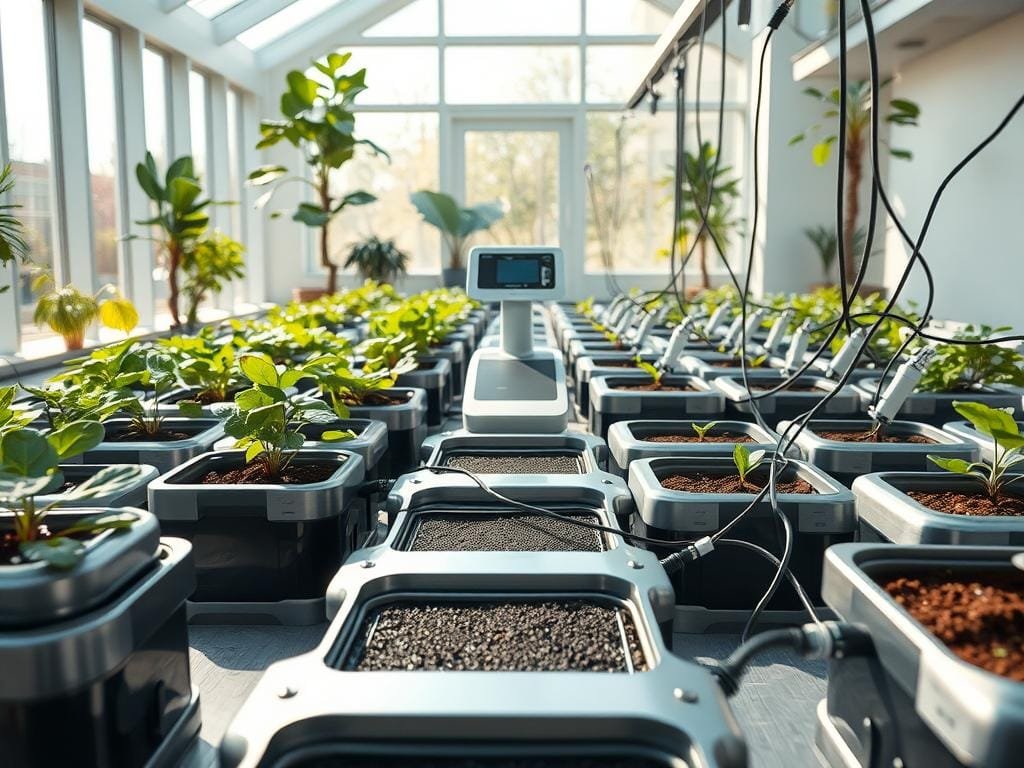Did you know a smart garden can grow plants 20% faster and use 30% less water?
With smart irrigation technology, your garden can thrive even when you’re away. It automates watering, giving plants the right moisture at the right time.
This saves you time and effort. It also prevents overwatering, which harms your plants. We’ll show you how to make a self-watering system for your indoor or outdoor garden.
Key Takeaways
- Create a self-sustaining garden with automated watering
- Increase plant growth and reduce water consumption
- Use smart irrigation technology for optimal results
- Build a self-watering system with our easy-to-follow guide
- Save time and effort with automated gardening
Introduction to Smart Garden Automation
Smart garden automation is changing how we take care of our plants. It makes gardening easier and keeps our gardens lush and healthy. With smart outdoor gadgets, you can automate watering, check soil moisture, and adjust the environment for better plant growth.
What is Smart Garden Automation?
Smart garden automation uses technology to automate gardening tasks like watering, pruning, and fertilizing. It combines sensors, automated irrigation, and control units for the best plant care.
Wireless garden monitoring lets you watch your garden in real-time. This helps you make quick decisions and adjustments.
Benefits of Smart Garden Automation
Smart garden automation offers many benefits, like healthier plants, less water use, and easier garden care. It automates routine tasks, saving you time. You can then focus on choosing plants and designing your garden.
Automated plant care systems prevent overwatering or underwatering. They ensure your plants get the right moisture at the right time.
Overview of Self-Watering Systems
Self-watering systems are a key part of smart garden automation. They keep plants watered consistently. These systems have a water reservoir, drip irrigation, and soil sensors. They deliver water to the roots as needed.
Using a self-watering system means your plants get the right water. This reduces waste and lowers the chance of overwatering.
Components of a Self-Watering System
To create a good automated watering system, knowing the main parts is key. These parts work together to give your plants the right water at the right time. This makes gardening easier and less work.
Water Reservoir
A water reservoir holds water for your plants. Pick one that’s big enough but not too big for your garden.
Drip Irrigation System
The drip irrigation system sends water straight to the roots. This cuts down on water lost to evaporation and runoff. It’s efficient and can be set up to fit your garden’s layout.
Soil Moisture Sensors
Soil moisture sensors check how wet the soil is. They send live data to the system. This helps it know when to water your plants just right.
- Monitor soil moisture levels
- Provide real-time data
- Help in optimizing watering schedules
Control Unit
The control unit is the system’s brain. It uses data from the sensors to control the water flow. It’s what makes watering plants automatic.
“The control unit is the heart of any automated watering solution, making it possible to manage your garden’s watering needs efficiently.”
Key Technologies in Smart Gardening
Smart gardening uses new technologies to make gardening easier. These tools work together to make gardening simple and efficient.
IoT (Internet of Things)
The Internet of Things (IoT) is key in smart gardening. It connects devices and sensors online. This lets you monitor and control your garden in real-time.
Soil moisture sensors check the soil’s moisture and send updates to your phone or computer. This helps you decide when to water. For more on smart gardening tools, check out this blog post.
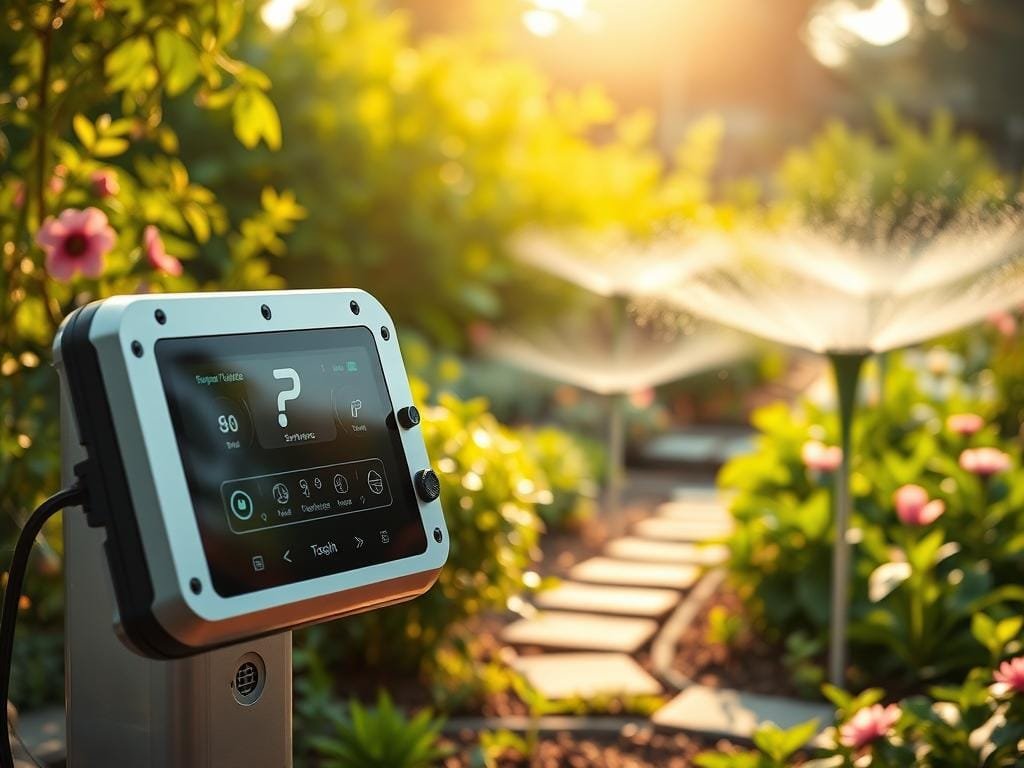
Automation Software
Automation software is the heart of smart gardening. It uses data from sensors to control your garden, like irrigation systems. It can adjust water use based on soil type, plants, and weather.
This software automates tasks, saving you time. It ensures your garden gets the care it needs.
Mobile App Integration
Mobile apps are a big part of smart gardening. They let you check on and control your garden from anywhere. You can get updates, change settings, and schedule waterings through the app.
This control makes gardening easier, even when you’re away. These technologies help you achieve your gardening goals with less effort.
Designing Your Self-Watering System
A well-designed self-watering system keeps your plants healthy and saves water. You need to think about your garden’s size, the plants you have, and the local weather.
Assessing Your Garden Space
Start by looking at your garden. Think about its layout, soil, and sunlight. Use DIY Smart Watering System guides to learn what your garden needs.
Notice where your plants need more water and where they dry out fast. This helps you place your water reservoir and drip irrigation system correctly.
Choosing the Right Plants
Not all plants need the same amount of water. Pick plants that match your garden’s conditions. This is key for your system’s success.
In dry climates, choose plants that need less water. In cool, moist areas, plants that like more water are better. Vertical farming can also help use space well and water efficiently.
Planning the Layout
After assessing your garden and picking plants, plan your system’s layout. Decide where to put the water reservoir, drip irrigation, and soil moisture sensors.
A good layout ensures your plants get the right water at the right time. Always test your system on dummy soil before using it to avoid problems.
| Component | Description | Importance |
|---|---|---|
| Water Reservoir | Holds water for the irrigation system | High |
| Drip Irrigation System | Delivers water directly to the roots | High |
| Soil Moisture Sensors | Monitors soil moisture levels | Medium |
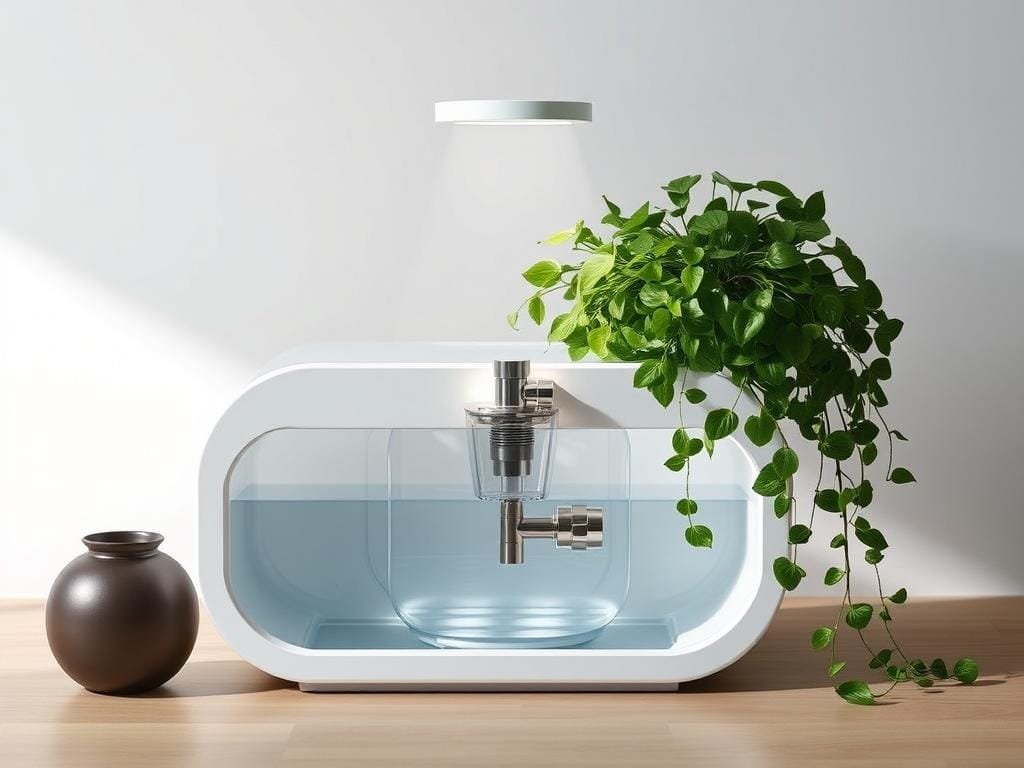
Installation Process
To start your automated watering solution, follow this guide. It will help you set up your IoT garden management system. The process has several steps to ensure your garden gets the right water at the right time.
Setting Up the Water Reservoir
The first step is setting up the water reservoir. This container holds the water for your plants. Pick a size that fits your garden’s needs but is easy to refill.
Key Considerations:
- Size: Make sure the reservoir fits your garden.
- Material: Choose something durable and algae-resistant.
- Accessibility: Place it where you can easily refill it.
Installing Drip Irrigation
Drip irrigation is key for your system. It waters plants directly, cutting down on evaporation and runoff. Lay out the tubing to match your garden’s layout, making sure each plant gets enough water.
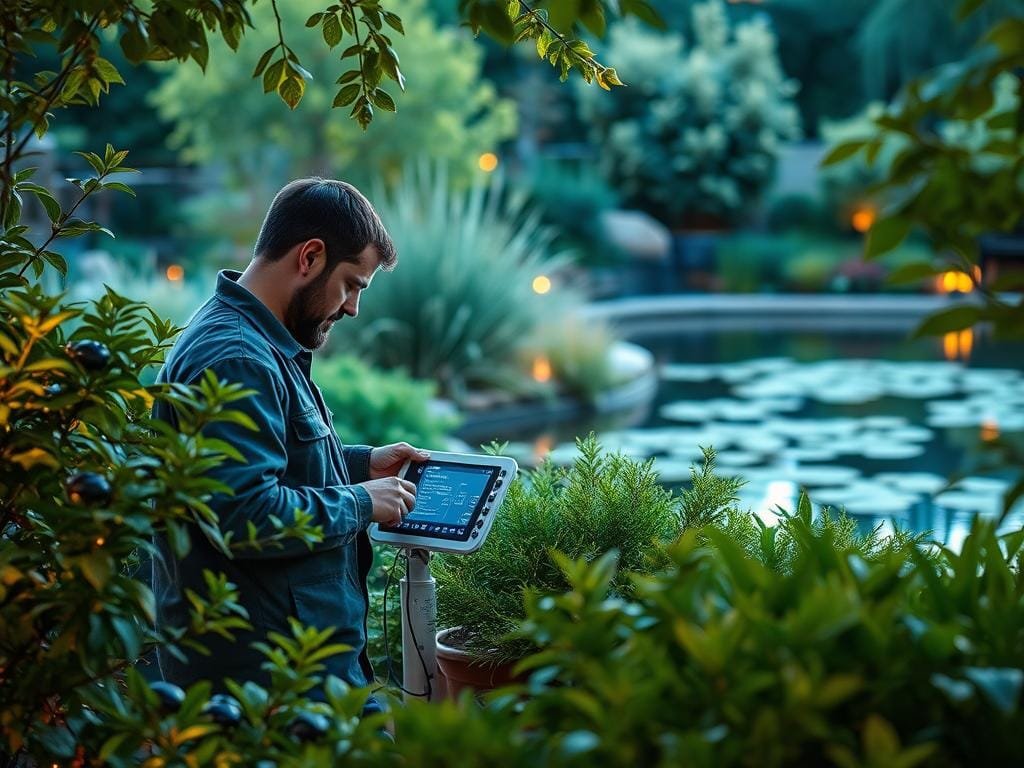
Connecting and Calibrating Sensors
Soil moisture sensors are essential for managing your garden. They check soil moisture and start the watering system when needed. Follow the manufacturer’s guide to connect and calibrate them for accurate readings.
Calibration Steps:
- Put the sensor in the soil at the right depth.
- Adjust the sensor’s sensitivity based on the soil type.
- Test the sensor to make sure it’s reading moisture levels correctly.
Here’s a quick summary of the installation steps:
| Step | Description | Key Considerations |
|---|---|---|
| 1 | Setting Up the Water Reservoir | Size, Material, Accessibility |
| 2 | Installing Drip Irrigation | Tubing Layout, Water Distribution |
| 3 | Connecting and Calibrating Sensors | Sensor Placement, Sensitivity Adjustment |
By following these steps and considering the important factors, you can install an automated watering system. It will help your smart garden thrive.
Maintenance of Smart Garden Systems
Keeping your smart garden system in top shape is key. A well-kept system lasts longer and makes sure your plants get the right care. This includes the right amount of water and nutrients.
Regular Checks and Adjustments
It’s important to regularly check your smart garden’s health. Look at the water reservoir, drip lines, and soil sensors often. Check for blockages, leaks, or any issues. Adjust settings as needed for weather or plant growth changes.
In hot summers, you might need to water more often. In cooler months, you might water less. Smart garden tips can help you adjust your system for the seasons.
Cleaning and Winterizing
Cleaning your smart garden system is key to avoid clogs. Clean the water reservoir and irrigation parts often. Before winter, winterize your system to avoid freezing damage.
“Drain the water from the pipes, and consider using compressed air to blow out any remaining water. This will help prevent ice from forming and damaging your system.”
Troubleshooting Common Issues
Even with regular care, problems can happen. Issues like clogged emitters, faulty sensors, and leaks can occur. Knowing how to fix these quickly saves time and keeps your plants safe.
| Issue | Cause | Solution |
|---|---|---|
| Clogged Drip Emitters | Debris or mineral buildup | Clean or replace emitters |
| Faulty Sensors | Calibration issues or damage | Recalibrate or replace sensors |
| Leaks in Irrigation System | Damage or wear and tear | Repair or replace damaged sections |
By following these tips, your smart garden system will keep working well. It will give your plants the care they need.
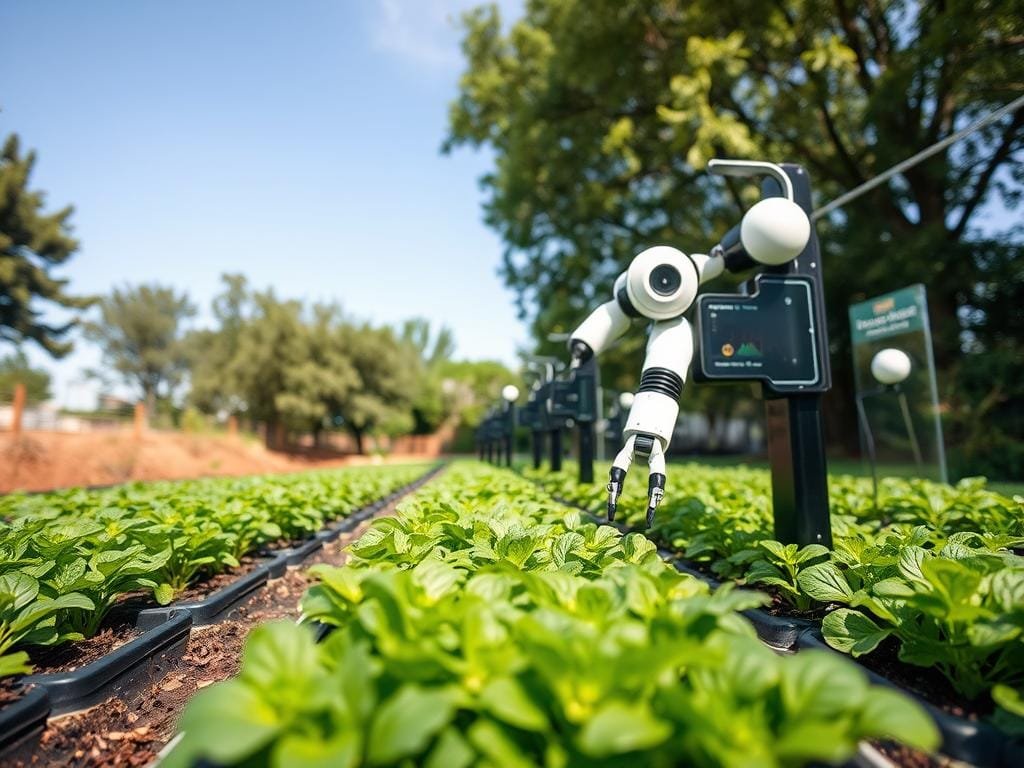
Advanced Features to Enhance Automation
There are many ways to make your garden smarter. By using the latest technology, you can make your gardening easier and more fun. This means your garden will work better for you.
Weather Monitoring Tools
Weather tools are key for a smart garden. They help your garden know when to water, based on the weather. For example, a rain sensor stops watering when it rains, saving water and preventing too much.
There are many weather tools that work with your garden system. They give you updates on temperature, humidity, and rain. This helps your garden water itself just right, no matter the weather.
Remote Monitoring Capabilities
With remote monitoring, you can watch your garden from anywhere. A mobile app lets you check soil moisture, see the weather, and change watering times. This keeps your garden healthy, even when you’re away.
For example, you can check on your garden while on vacation. This is great for busy people or those who travel a lot. You’ll also get alerts if something goes wrong, so you can fix it fast.
Integration with Smart Home Systems
Connecting your garden to your smart home makes things even better. Many garden devices work with popular smart home systems. This lets you control your garden with your other smart devices.
You can set up routines for watering based on your day or the season. You can even use voice commands with Alexa or Google Assistant. For more on smart homes, check out this guide for tips and gadgets that won’t break the bank.
| Feature | Description | Benefits |
|---|---|---|
| Weather Monitoring Tools | Devices that track weather conditions | Water conservation, prevents overwatering |
| Remote Monitoring Capabilities | Mobile app control for garden oversight | Convenience, timely issue resolution |
| Smart Home Integration | Compatibility with smart home platforms | Enhanced home automation, voice control |
Eco-Friendly Benefits of Automation
By using automated plant care, you make gardening easier and help the planet. Connected garden devices in your routine can greatly help the environment.
One big eco-friendly plus of automated watering is water conservation. Old ways of gardening often waste water. But, automated systems give plants just the right amount of water, saving water.
Water Conservation
Automated systems water plants in the morning or evening. This cuts down on evaporation and helps plants soak up water better. It saves water and eases the load on your water supply, making gardening more sustainable.
Reducing Chemical Use
Automated gardens also cut down on chemical use. They keep watering just right, so you don’t need to use as many fertilizers and pesticides. Healthy plants fight off pests and diseases better, needing fewer chemicals. For more on how tech changes our lives, check out ambient computing.
Promoting Biodiversity
Also, automated gardening boosts biodiversity in your garden. It creates a stable, healthy space for more plants and animals. This biodiversity is key for a strong ecosystem and makes your garden a wildlife sanctuary.
In summary, automating your garden’s watering has many eco-friendly perks. It saves water, cuts down on chemicals, and boosts biodiversity. By using automated watering solutions, you help make gardening more sustainable for you and the planet.
Case Studies of Successful Smart Gardens
Automated gardening systems have shown great results in many gardens. They help people and groups grow beautiful gardens with little help from them.
Urban Spaces
In cities, space is tight, making smart gardens very useful. A rooftop garden in New York City used a system to watch over watering, temperature, and light. It saw a 30% increase in crop yield over old ways of gardening.
“The integration of smart gardening technologies has transformed urban agriculture, enabling us to produce more with less.” –
Suburban Gardens
Suburban gardens also gain a lot from smart gardening. A garden in California cut water use by 25% with smart irrigation and soil checks.
- Reduced water waste
- Increased plant health
- Lower maintenance costs
Commercial Applications
Commercial gardens and greenhouses see big wins with smart gardening. A greenhouse in Florida used a system for climate, water, and food. It cut costs and improved food quality.
A manager said, “The automation system has changed our game. It lets us grow our business while our garden grows.”
Conclusion: The Future of Smart Gardening
Smart garden automation is changing how we care for plants. It combines smart irrigation, automated care, and wireless monitoring. This makes gardening more efficient and green.
Emerging Trends
The future of gardening looks bright. Automation and data analytics will play big roles. Expect systems that use weather, soil, and plant health for better care.
Adopting the Technology
Using smart gardening tech makes gardening easier and helps the planet. Automated systems save water, and wireless monitoring lets you check your garden from anywhere.
Looking Ahead
Smart irrigation will keep getting better. These advancements will make gardening more effective and eco-friendly. They’ll also improve your gardening experience and help the environment.
FAQ
What is smart garden automation?
Smart garden automation uses technology to make gardening easier. It includes tasks like watering and pruning. It also helps monitor plant health. This is done with devices like sensors and mobile apps.
How does a self-watering system work?
A self-watering system uses sensors and valves to water plants. It checks soil moisture and weather. This ensures plants get the right amount of water.
What are the benefits of using automated gardening systems?
Automated gardening systems save water and reduce work. They also keep plants healthy. Gardeners can check their gardens from anywhere, making it easier to care for them.
What is the role of IoT in smart gardening?
IoT connects devices in smart gardening. It lets gardeners check and control their gardens from anywhere. They get updates and insights on plant health.
How do I choose the right plants for my self-watering system?
Choose plants that fit your climate and soil. Pick ones that need similar water. This makes caring for them easier.
What are some common issues with smart garden systems, and how can I troubleshoot them?
Issues include sensor problems and irrigation failures. Check sensors and controllers. Make sure your system is connected.
Can I integrate my smart garden system with my smart home system?
Yes, many systems can connect with smart homes. This lets you control your garden with other devices.
How can I ensure that my smart garden system is eco-friendly?
Use rainwater and reduce chemicals. Optimize water use with weather tools. This makes your garden more eco-friendly.
What are some advanced features that can enhance my automated gardening system?
Features like weather tools and remote monitoring improve your system. They help save water and keep plants healthy.
How can I maintain my smart garden system?
Regularly check and adjust your system. Clean and winterize it. Update software for the latest features and security.
